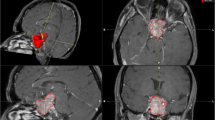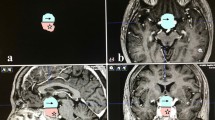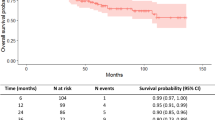Abstract
The objective of the study was to evaluate the preoperative visual field defect, the postoperative outcome and the possible prognostic factors in patients with pituitary macroadenoma, using a quantitative method (the mean deviation = MD), and to review the literature. A total of 73 patients, operated trough trans-sphenoidal approach, were selected, and data in single eyes were analysed by calculating the frequency and the degree of postoperative improvement (relative improvement). The visual field defect improved in 95.7% of eyes: The recovery was complete in 48.9% and partial in 46.8%. Multivariate logistic regression showed that factors, independently predictive for complete recovery, were as follows: low preoperative MD absolute value (p = 0.008), low cranio-caudal diameter of tumour (p = 0.02) and young age (p = 0.0001). The mean relative improvement in visual field defect (dMD%) was correlated with the preoperative visual acuity (p = 0.0001) and inversely related with the preoperative MD (p = 0.007) and the age (p = 0.017). The relative improvement was higher in tumours with a smaller cranio-caudal diameter (p = 0.0185). In conclusion, using a quantitative method, we can measure the degree of the postoperative visual field defect improvement. Predictive factors for a complete recovery were good preoperative visual function, young age and low cranio-caudal tumour.





Similar content being viewed by others
References
Barzaghi LR, Losa M, Giovanelli M et al (2007) Complications of transsphenoidal surgery in patients with pituitary adenomas: experience at a single centre. Acta Neurochir 149:877–885
Bergland R, Ray BS (1969) The arterial supply of the human optic chiasm. J Neurosurg 31:327–334
Blaauw G, Braakman R, Cuhadar M et al (1986) Influence of transsphenoidal hypophysectomy on visual deficit due to a pituitary tumour. Acta Neurochir 83:79–82
Ciric I, Mikhael M, Stafford T et al (1983) Transsphenoidal microsurgery of pituitary macroadenomas with long-term follow-up results. J Neurosurg 59:395–401
Cohen AR, Cooper PR, Kupersmith MJ et al (1985) Visual recovery after transsphenoidal removal of pituitary adenomas. Neurosurgery 17:446–452
El Azouzi M, Black PM, Candia G et al (1990) Transsphenoidal surgery for visual loss in patients with pituitary adenomas. Neurol Res 12:23–25
Findlay G, Mc Fadzean RM, Teasdale G (1983) Recovery of vision following treatment of pituitary tumours; application of a new system of assessment to patient treated by transsphenoidal operation. Acta Neurochir 68:175–186
Gnanalingham KK, Bhattacharjee S, Pennington R et al (2005) The time course of visual field recovery following transsphenoidal surgery for pituitary adenomas: predictive factors for a good outcome. J Neurol Neurosurg Psychiatry 76:415–419
Hudson H, Rissell C, Gauderman WJ et al (1991) Pituitary tumor volume as a predictor of postoperative visual field recovery. Quantitative analysis using automated static perimetry and computed tomography morphometry. J Clin Neuroophthalmol 11:280–283
Jagle H, Zrenner E, Krastel H, Hart W (2007) Dyschromatopsias associated with neuro-ophthalmic disease. In: Marion P (ed) Clinical Neuro-ophthalmology. Springer, Berlin–Heidelberg, pp 71–85
Katz J, Sommer A (1988) Reliability indexes of automated perimetric tests. Arch Ophthalmol 106:1252–1254
Kerrison JB, Lynn MJ, Baer CA et al (2000) Stages of improvement in visual fields after pituitary tumor resection. Am J Ophthalmol 130:813–820
Laws ED Jr, Trautmann JC, Hollenhorst RW Jr (1977) Transsphenoidal decompression of the optic nerve and chiasm. Visual results in 62 patients. J Neurosurg 46:717–722
Marazuela M, Astigarraga B, Vicente A et al (1994) Recovery of visual and endocrine function following transsphenoidal surgery of large nonfunctioning pituitary adenomas. J Endocrinol Invest 17:703–707
McIlwaine GG, Carrim ZI, Luek CJ et al (2005) A mechanical theory to account for bitemporal hemianopia from chiasmal compression. J Neuro-Ophthalmol 25:40–43
Monteiro ML, Zambon BK, Cunha LP (2010) Predictive factors for the development of visual loss in patients with pituitary macroadenomas and for visual recovery after optic pathway decompression. Can J Ophthalmol 45:404–408
Mortini P, Losa M, Barzaghi R et al (2005) Results of transsphenoidal surgery in a large series of patients with pituitary adenoma. Neurosurgery 56:1222–1233
Nakane T, Kuwayama A, Watanabe M et al (1981) Transsphenoidal approach to pituitary adenomas with suprasellar extension. Surg Neurol 16:225–229
Peter M, De Tribolet N (1995) Visual outcome after transsphenoidal surgery for pituitary adenomas. Br J Neurosurg 9:151–157
Powell M (1995) Recovery of vision following transsphenoidal surgery for pituitary adenomas. Br J Neurosurg 9:367–373
Schiefer U, Schiller J, Hart W (2007) Perimetry. In: Marion P (ed) Clinical neuro-ophthalmology. Springer, Berlin–Heidelberg, pp 29–53
Shrivastava RK, Arginteanu MS, King WA et al (2002) Giant prolactinomas: clinical management and long-term follow up. J Neurosurg 97:299–306
Sullivan LJ, O’Day J, McNeil P (1991) Visual outcomes of pituitary adenoma surgery. St. Vincent’s Hospital 1968–1987. J Clin Neuroophthalmol 11:262–267
Suzukawa K (1989) Evaluation of the transcranial approach to pituitary adenomas based on quantitative analysis of pre- and postoperative visual function. Neurol Med Chir (Tokyo) 29:1012–1019
Trautmann JC, Laws ER Jr (1983) Visual status after transsphenoidal surgery at the Mayo Clinic, 1971–1982. Am J Ophthalmol 96:200–208
Conflict of interest
The authors declare that they have no conflict of interest.
Author information
Authors and Affiliations
Corresponding author
Additional information
Comments
Miguel A. Arraez, Malaga, Spain
In this article from Barzaghi et al., the authors analyse the results in their series of 73 patients identifying the factors responsible for the visual outcome after transsphenoidal surgery. The interest of this paper is the review of several other parameters different from visual field defect. These other factors impairing vision are frequently forgotten when analysing the impact of pituitary adenomas and transsphenoidal surgery in visual function: this paper nicely explains the physiopathology and mechanisms resulting in impairment of the visual acuity (macular fibres) and colour perception, very seldom reflected in the publications about pitutary adenoma and visual pathways impairment. The authors very honestly pointed out that several transcendent factors responsible for visual damage (prefixed of postfixed chiasm, position and morphology of the tumor, dehiscence of sellar diaphragm, vascularisation of optic apparatus) cannot be properly evaluated.
Michael Buchfelder, Erlangen, Germany
Loss of vision is one of the classical presenting symptoms of pituitary adenomas and for a century we read in the medical literature that mostly surgical decompression of the visual pathways is followed by some recovery. However, the degree of recovery is extremely variable. It may occur by improvement of the visual fields or visual acuity in one eye or bi-laterally. Many investigators have in the past assessed the functional result of pituitary tumour operations in respect to vision and tried to identify prognostic factors, which allowed to predict better or worse results. In the present analysis a cohort of patients have been assessed in a systematic fashion for every individual eye. The prognostic factors predicting good outcome confirm previously published factors, such as young age of the patient, a minor degree of loss of vision and a smaller tumour. An asset of this paper is the excellent methodology with which this clinical study was carried out. Moreover, the authors need to be congratulated for their excellent surgical results. I would just like to add a word of caution in respect to redo procedures. Since all patients in this study underwent primary surgery, the authors could not confirm what we learn from other publications on this topic, namely that one other important factor is whether the operation is a primary intervention or repeat surgery. In the latter case the degree of recovery is clearly less favourable.
William T. Couldwell, Utah, USA
In this study, the authors have analysed the visual acuity and field defects in single eyes among a series of 73 patients undergoing surgical resection of pituitary macroadenomas. In patients with bigger tumors, the visual acuity was lower and the colour vision impairment more frequent compared to patients with smaller tumors, but the difference between the two groups was not significant. Visual field defects were noted in all patients; the authors note that 95.7% of the affected eyes demonstrated improvement in visual field defect following transsphenoidal surgical removal, over a mean followup period of 27 months. As experienced surgeons intuitively suspect, the degree of improvement was related to the age of the patient (younger better), smaller tumors in cranio-caudal diameter and those with lesser visual field defects. The authors nicely document the improvement in visual fields objectively with the quantitative MD values pre- and postoperatively. Somewhat surprisingly, they noted that the duration of preoperative symptoms was an important factor in determining the preoperative MD, but only partially affected the postoperative improvement, indicating even those patients with long standing defects may gain improvement with surgical decompression.
While they note that the cranio-caudal diameter is important for prediction of improvement, it would have been helpful if they had separately commented on the absolute value of suprasellar extent and the degree of chiasmal and nerve compression. Depending upon the growth pattern of the tumour (downward with erosion of the clivus vs. pure suprasellar growth upward), tumours with the same cranio-caudal diameter may produce quite different compression of the optic pathways. This comment notwithstanding, the authors are to be congratulated on their nice contribution to the literature, which contains real information that is helpful in counseling all patients who suffer from visual loss from a pituitary macroadenoma as to their chances of visual improvement following surgery
Rights and permissions
About this article
Cite this article
Barzaghi, L.R., Medone, M., Losa, M. et al. Prognostic factors of visual field improvement after trans-sphenoidal approach for pituitary macroadenomas: review of the literature and analysis by quantitative method. Neurosurg Rev 35, 369–379 (2012). https://doi.org/10.1007/s10143-011-0365-y
Received:
Revised:
Accepted:
Published:
Issue Date:
DOI: https://doi.org/10.1007/s10143-011-0365-y




